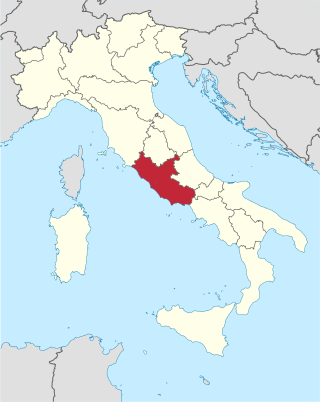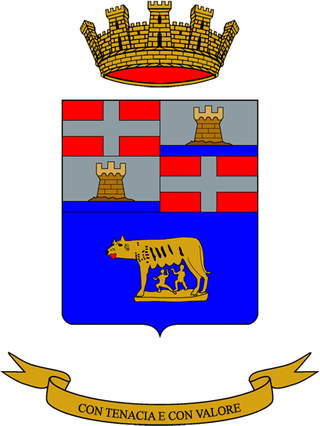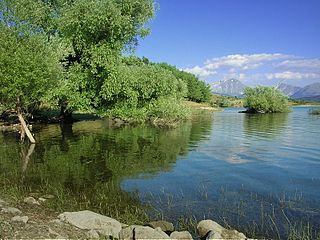Ordinary regions
| Flag | Year of adoption | Use | Description |
|---|---|---|---|
 | 1999 | Flag of Abruzzo | A burgundy field with the coat of arms of Abruzzo in the centre. White represents the snowy mountains, green the hills of the region, and blue the Adriatic sea. [1] [2] |
 | 2001 (modified in 2011) | Flag of Apulia | A white field with the words Regione Puglia ("Apulia Region") in gold letters at the top center, with the coat of arms of Apulia below; a green stripe towards the hoist-side, and a red stripe towards the fly-side. [3] The shield, mounted by the crown of Frederick II, is composed of six bezants (coins) at the top, representing the six provinces of Apulia; prior to the creation of the province of Barletta-Andria-Trani in 2009, there were only five bezants; [4] [5] ; an octagon, representing the Castel del Monte built by Frederick II; [3] an olive tree, a symbol of peace and brotherhood and a common feature of the Apulian countryside. [3] The stripes of green and red, set against the white background, are a reference to the national flag of Italy. |
 | 1995 | Flag of Basilicata | The flag is the coat of arms of Basilicata superimposed on the a field of azure. An unofficial variant has "Regione Basilicata" above the coat of arms, a gold-bordered white shield with four blue waves, representing the four major rivers of the region: the Basento, Agri, Bradano and Sinni. [6] [7] |
 | 1995 | Flag of Calabria | The flag is the coat of arms of Calabria superimposed on the a field of blue, with the words "Regione Calabria" above and below the arms. The coat of arms, adopted on 15 June 1992, is a disc, quartered in saltire, with, clockwise from the top, a pine tree, a Teutonic cross, a light blue truncated Doric column and a Byzantine cross. [8] [9] |
 | Flag of Campania | The flag is the coat of arms of Campania superimposed on the a field of azure. The coat of arms of Campania has as its coat of arms the one that the Maritime Republic of Amalfi gave itself at its dawn. This coat of arms consists of a red band on a white field. [10] | |
 | 1995 | Flag of Emilia-Romagna | The emblem of the region superimposed upon a field of white, with a red bar and the words "Regione Emilia-Romagna" below. The emblem represents the geographical profile of the region. According to the designer, the curved line represents the Po river and nature, while the straight line represents the road and the work of man. The green colour represents that of the Po Valley. [11] [12] [13] |
 | Flag of Lazio | The flag is the coat of arms of Lazio surrounded by laurel and olive branches, surmounted by a golden crown on a sky-blue field with the words "Regione Lazio" in gold. [14] [15] [16] The coat of arms of the Lazio region consists of an octagon edged in gold in which the coat of arms of the province of Rome are inserted in the centre and the coats of arms of the provinces of Frosinone, Latina, Rieti and Viterbo tied together by a tricolour ribbon. [17] | |
 | 1997 | Flag of Liguria | The flag is the coat of arms of Liguria superimposed on tricolour green, red and blue field. Each colour of thew field has the following meaning: [18] the green represents the Ligurian Alps and the Ligurian Apennines; the red represents the blood shed for Italian unification; the blue represents the Ligurian Sea. At the center of the flag is the coat of arms of Liguria: a stylized caravel, symbolizing the maritime traditions of the region and its great navigators, positioned below the historical flag of the Republic of Genoa (the current flag of the modern-day city of Genoa). The four six-pointed stars imposed on the Genovese flag represent the four provinces of Liguria: the Province of Genoa, the Province of Imperia, the Province of La Spezia, and the Province of Savona. [19] |
 | 1975 | Flag of Lombardy | The flag is a field of green, representing the Po Valley, with the Camunian rose (a symbol of the region derived from a prehistoric drawing made by the ancient Camuni) in white in the centre, representing the light. [20] [21] [22] In Camonica Valley, Camunian roses dates back to the Iron Age, particularly from the 7th to 1st centuries BC. These figures are placed mainly in the Middle Camonica Valley (Capo di Ponte, Foppe of Nadro, [23] Sellero, Ceto and Paspardo), but numerous cases are in the Low Valley too (Darfo Boario Terme and Esine). The Camunian rose had originally a solar meaning, which then developed into a wider meaning of a positive power, to bring life and good luck. [24] |
 | 1995 | Flag of Marche | The flag of Marche bears a stylized woodpecker, overlapping a black shape to form a capital letter M, against a green-bordered shield with a white field. [25] [26] The woodpecker was the tribal totem of the Picentes, an Italic tribe who lived in most of the territory of present-day Marche. The bird's connection to the region is attested to in Greek and Roman literature. [27] [28] |
 | 1975 | Flag of Molise | The flag is a field of light blue, with the coat of arms of the region (red with a diagonal silver band and an eight-pointed white star in the canton) in the centre. The words "Regione Molise" are in gold below. [29] [30] [31] |
 | 1995 | Flag of Piedmont | The flag of Piedmont is essentially the arms of the Prince of Piedmont, the title for the eldest son of the King of Sardinia. [32] When Duke Amadeus VIII of Savoy gave his eldest surviving son the title of "Prince of Piedmont" in 1424, he added a heraldic label to the coat of arms distinguish it from the general coat of arms of the House of Savoy. [33] |
 | 1995 | Flag of Tuscany | The flag depicts a silver Pegasus rampant on a white field between two horizontal red bands. The Pegasus image on the flag derives from a coin made by the Florentine artist Benvenuto Cellini in 1537. This coin was created by Cellini in order to honour Cardinal Pietro Bembo. [34] Bembo was instrumental in the development of the Tuscan language as a literary medium and was honoured with the representation of Pegasus due to its symbolism and ties with creation. [35] As a result, the Pegasus came to be associated as a symbol of the Tuscan region. [34] |
 | 2004 | Flag of Umbria | A green field with the regional symbol in the center with the stylization of the three candles of the Corsa dei Ceri held in Gubbio in province of Perugia on 15 May every year in honor of Sant'Ubaldo Baldassini. [36] |
 | 1975 (modified in 1999) | Flag of Veneto | The flag Veneto derives from the flag historically used by the Republic of Venice (697–1797), a maritime republic centered on the modern city of Venice. The coat of arms of the Region is set in a square in the center of the flag: the Lion of Saint Mark with the opened gospel (reading the Latin motto Pax tibi Marce evangelista meus, "Peace to you Mark, my evangelist") rests its paws on the landscape of Veneto: sea (the Adriatic), land (the Venetian Plain) and mountains (the Alps). [37] Attached to the fly edge are seven tails. Each one bears in the middle the coat of arms of one of Veneto's seven province capitals, [37] tricolour ribbon is to be knotted just below the flagpole finial. |



















